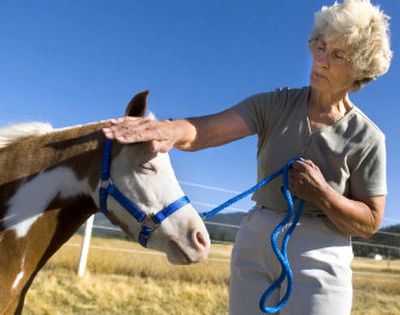HIGH AND MINI

A Greenacres horse stands tall these days with a national grand champion win.
Named Sundance LB Que-Tee, this mare has the sleek legs and elegant head of any top-winning horse, yet she stands at 34 inches. She is one of 18 miniature horses cared for by Serendipity Stables owner Sharon Stadler.
A 62-year-old retired nurse, Stadler entered the business of diminutive equine about six years ago on a whim and now has a full-fledged breeding business on acreage southwest of the Saltese area.
“I got interested in miniature horses when my granddaughter was the Deer Park princess,” said Stadler, a horse owner since age 9. “You go to all these parades, and they have miniature horses in these parades. I said, ‘Oh, those are cute.’ I started looking for one as a pet. It just went from there.”
“I fell in love with the miniatures and enjoy them so much.”
Stadler was on hand at the Sept. 7-16 American Miniature Horse Registry National Show in Tulsa, Okla., when judges announced her first national grand champion in Que-Tee, a 3-year-old sorrel overo pinto.
“She’s the color of a red-haired woman and she has big blue eyes,” added Stadler, when asked to describe the horse’s coloring.
The show has more than 1,900 entries of miniature horses in two categories: those 34 inches to 38 inches called “over” and horses 34 inches or less called “under.” As a comparison, a standard 15-hand quarter horse stands about 60 inches.
Stadler’s win is big in miniature horse circles, and she cried at the announcement.
“A huge part of it is the horse’s presence,” Stadler explained. “There’s just that little something extra that makes that horse stand out. I believe it was her presence. Even out here in the stall, dirty, it’s, ‘I’m the princess.’ She’s very feminine.”
Stadler is still fond of the regular horses she previously bred and has kept “one token quarter horse” named Hawkeye. While her husband, Frank, helps with “honey do” lists, Stadler is the main horse-business operator. She has found it actually easier to care for miniatures as a one-person operation.
“They’re so much easier to take care of than a regular horse,” she said. “You can feed five of them for one big horse, and they’re easier to handle. But they’re still a horse with different personalities.”
The history of miniature horses in the United States goes back to the 1800s, Stadler said. It started after Shetland ponies were brought over from Europe to work in the coal mines pulling carts, she explained, and people started breeding the tiniest ones.
“They called them midget Shetlands, and then it evolved through breeding and infusing Shetland blood lines,” Stadler said. “The miniature today is not the short-legged long-bodied miniatures of yesterday.”
Stadler added that today’s miniature horses are clearly distinct from ponies in appearance. Modern miniature horses closely resemble standard horses in many ways, and in industry magazines, miniatures are photographed in regal poses.
“In a photo, without a frame of reference, you can’t tell them from a regular horse. Through selective breeding, they look very much like a standard-sized horse. Now, they have sleeker, longer legs and longer necks – a more Arab type look to them – and prettier heads than old-time miniatures.”
Not long after embarking on miniatures, Stadler started looking for ones with the overo paint color pattern. She sold her first stallion and found an overo named Baron. She eventually added a couple more stallions and mares.
Since 2002, she has run the breeding operation as a business versus a hobby. Her role includes daily feeding, cleaning and care. Her time gets especially busy during spring with breeding, foaling and the show season. If a mare is set to give birth, Stadler is constantly on duty, utilizing 24-hour camera monitors with alarms.
“It’s 24/7. With miniatures, you can have more complications – malpresentations. You’ve got to attend the birth of a miniature foal.”
Miniatures that are pet quality can go for $500, she said. A show quality miniature will cost around $5,000 and some high-end horses have had price tags over $100,000.
“People always ask, ‘What do you do with a miniature?’ ” Stadler added. “I say, you do everything with a miniature you do with a regular horse except ride them.”
However, a small child can ride some miniatures.
Other than being fun to look at, miniatures can pull a cart holding a person, do jumping or hunter-style jumping events, and perform in what’s called halter obstacle, like trail and hand for standard horses, in shows.
The Spokane area has many breeders in the miniature horse business. Stadler is treasurer of the Inland Empire Miniature Horse Club, with about 30 to 35 members. Prior to training in Arkansas, Que-Tee trained at the Heart L Ranch in Deer Park.
Stadler named her stable, Serendipity, because she thought the title was appropriate to explain her experience with the miniatures.
“Because it was very serendipitous how I got involved. I stumbled onto it, and it’s fun.”